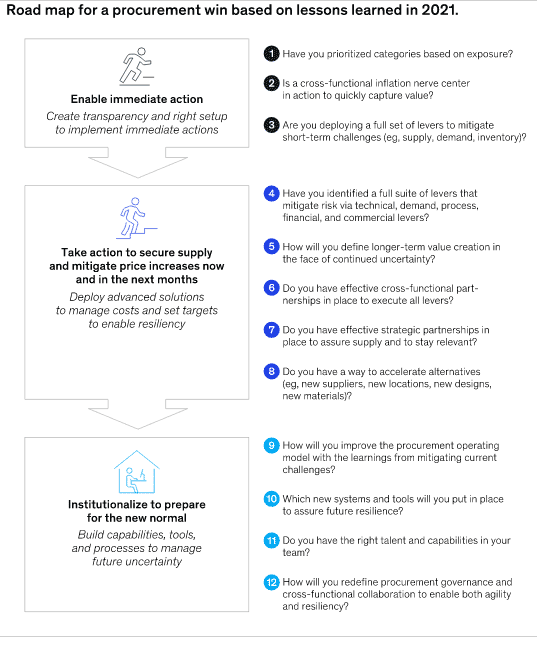It has been an incredible change for procurement organizations since the start of the pandemic in March 2020, quickly moving from a world of reliable supply and and largely stable prices to rampant supply disuptions and soaring price inflation.
What is procurement to do, in an environment most managers and even executives have never seen?
Supply Chain Digest Says...
|
 |
| When it comes to battling soaring prices, McKinsey says that companies are building deep insights into supplier economics and embedding them into smarter contracting models. |
 |
What do you say? |
| Click here to send us your comments |
|
 |
| Click here to see reader feedback |
|
The consultants at McKinsey recently pondered such questions, and say procurement executives can assess their organization’s readiness to step up with a few key questions, as follows:
• Have we quantified the potential impact of inflation, volatility, and supply chain disruptions at the commodity and supplier level?
• Do we deeply understand our suppliers’ industries and their dynamics? How are we sharing our insights with other functions to help protect revenues and margins?
• Do we have a road map to protect margins and mitigate supply risk via pricing, technical, demand, inventory, process, design, financial, and commercial levers?
• Do we have a proven playbook to recover and then control costs as inflationary pressures subside, volatility trends change, and supply chains are redesigned?
• How are we embedding the learnings and improvements from this challenging period into our go-forward operating model? How can we incorporate noneconomic factors in our decision making?
Following that exercise, McKinsey offers a 12-step action plan across three main action categories:
• Enabling immediate action
• Taking action to secure prices and mitigate future increases
• Institutionizing for a new normal
The roadmap graphic is published below:

Source: McKinsey
(See More Below)
|
CATEGORY SPONSOR: SOFTEON |
|
|
| |
|
|
Relative to taking immediate action, McKinsey says that "Transparency into spend and a view on input cost inflation by category and geography are critical. Gaining these insights requires an intimate understanding of the supply base and its economic drivers."
It adds that some leading companies are already increasing their use of techniques such as indexing and "should-costing" to determine areas of exposure and create fact bases for discussions with suppliers. McKinsey says companies that cannot easily link their major categories to an index have experienced the biggest challenges, given the opacity of input-cost dynamics and their inability to use futures for category management.
In these categories, it adds, the use of cleansheeting, embedded-cost analytics, synthetic indexing, and deeper supply market insights has proven powerful in discovering the true magnitude of exposure and creating robust fact bases.
When it comes to battling soaring prices, McKinsey says that companies are building deep insights into supplier economics and embedding them into smarter contracting models.
It cites the example of an industrial manufacturer that was recently facing across-the-board supplier cost escalations. In reaction, the company has now documented every escalation request in granular detail. It sought to better understand the exact cost drivers of each product or service, improve its internal cost models, and build better contracts indexed to the right commodities and input costs.
"When the commodity cycle turns, it will be well-equipped to use this information to renegotiate many of its supply contracts," McKinsey says.
Relative to institutionalizing a new procurement operating model, McKinsey says that "Some companies have started setting up small agile teams focusing on advanced analytics and systems improvements to continue enabling a sophisticated, cross-functional approach to cost and margin management."
It cites the example of one integrated chemical producer that began a procurement transformation in late 2020 before inflation took off. As part of the journey, it set up a cross-functional transformation office that is now managing the producer’s inflation response at multiple levels.
Part of this transformation will involve new internal stategies, McKinsey say, including "stepping into the center of cross-functional value creation to apply a broad range of levers that put “everything in play” based on TCO and life-cycle views of spend; and "building deep expertise in supply market dynamics and supplier economics to become thought partners and innovation engines that optimize their operations through insight."
McKinsey concludes that "As procurement demonstrates its value to the enterprise, the stage will be set for procurement leaders to become full-fledged strategic partners to CEOs, CFOs, and COOs."
What do you think of McKinsey's procurement roadmap? Let us know your thoughts at the Feedback section below.
|